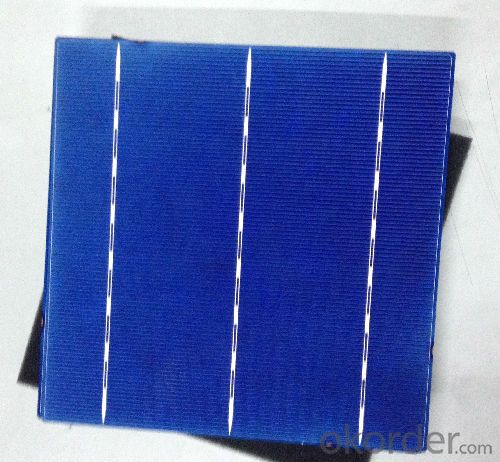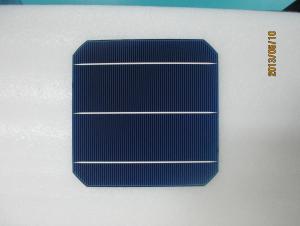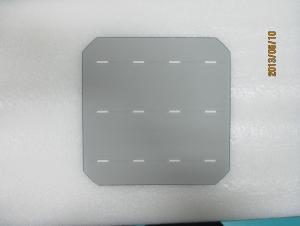156*156MM MONOCRYSTAL SOLAR CELL WITH HIGH EFFICIENCY
- Loading Port:
- Shanghai
- Payment Terms:
- TT or LC
- Min Order Qty:
- 1000 pc
- Supply Capability:
- 2000000 pc/month
OKorder Service Pledge
OKorder Financial Service
You Might Also Like
MONOCRYSTAL SOLAR CELL
Type:156M
Appearance:156×1565㎜±0.5mm; diagonal:R=100mm
Main fence wide:1.5mm back electrode wide:2.8mm
Fence line qty:90
Cell thickness:220±20
Eff(%) | 17.70- 17.80 | 17.80- 17.90 | 17.90- 18.00 | 18.00- 18.10 | 18.10- 18.20 | 18.20- 18.30 | 18.30- 18.40 | 18.40- 18.50 | 18.50- 18.60 | 18.60- 18.70 | 18.70- 18.80 | 18.80- 18.90 |
Pm(W) | 4.23 | 4.25 | 4.28 | 4.30 | 4.33 | 4.35 | 4.37 | 4.40 | 4.42 | 4.44 | 4.47 | 4.49 |
Isc(A) | 8.68 | 8.69 | 8.70 | 8.71 | 8.73 | 8.76 | 8.77 | 8.78 | 8.82 | 8.83 | 8.85 | 8.86 |
Im(A) | 8.13 | 8.15 | 8.17 | 8.19 | 8.21 | 8.24 | 8.26 | 8.30 | 8.33 | 8.35 | 8.39 | 8.42 |
Voc(V) | 0.626 | 0.627 | 0.628 | 0.630 | 0.631 | 0.632 | 0.633 | 0.634 | 0.634 | 0.635 | 0.636 | 0.637 |
Vm(V) | 0.522 | 0.523 | 0.525 | 0.527 | 0.528 | 0.529 | 0.531 | 0.531 | 0.532 | 0.534 | 0.534 | 0.535 |
FF(%) | 78.1 | 78.3 | 78.5 | 78.6 | 78.7 | 78.8 | 79.0 | 79.2 | 79.3 | 79.5 | 79.6 | 79.8 |

Packaging & Delivery of Polycrystalline Solar Cells
Carton Box Package and Deliver by air. It should be noticed that it should be avoid of water, sunshine and moist.
Factory Picture of Solar Cells


FAQ
We have organized several common questions for our clients,may help you sincerely:
What’s price per watt?
A: It’s depends on the quantity, delivery date and payment terms of the order. We can talk further about the detail price issue. Our products is high quality with lower price level.
Can you tell me the parameter of your solar cells?
We have different series of cells with different power output, both from c-si to a-si. Please take our specification sheet for your reference.
How do you pack your products?
We have rich experience on how to pack the panels to make sure the safety on shipment when it arrives at the destination.
Can you do OEM for us?
Yes, we can.
How long can we receive the product after purchase?
In the purchase of product within three working days, We will arrange the factory delivery as soon as possible. The perfect time of receiving is related to the state and position of customers. Commonly 7 to 10 working days can be served.
- Q:What is the history of solar cell development?
- The history of solar cell development dates back to the 19th century when the photovoltaic effect was first discovered by French physicist Alexandre-Edmond Becquerel in 1839. However, it wasn't until 1954 that the first practical silicon solar cell was developed by Bell Labs scientists. This breakthrough led to the commercialization of solar cells and their initial use in space applications, such as powering satellites. Throughout the 1960s and 1970s, solar cell technology continued to advance, primarily driven by research and development efforts in the United States. The energy crisis of the 1970s further fueled interest in renewable energy, including solar cells, leading to increased investment and technological advancements. In the 1980s and 1990s, solar cells became more efficient and affordable, making them increasingly popular for off-grid applications, such as powering remote locations and providing electricity to rural communities. Governments and organizations worldwide started implementing policies and incentives to promote solar energy adoption. In the early 2000s, there was a significant growth in the solar industry, driven by technological improvements, increased manufacturing scale, and declining production costs. This led to the widespread adoption of solar panels for residential and commercial use, as well as grid-connected solar power plants. Today, solar cells continue to evolve, with ongoing research focused on improving efficiency, durability, and reducing costs. The integration of solar cells into various applications, such as building materials and consumer electronics, further expands their potential. The solar industry plays a crucial role in the global shift towards clean and sustainable energy sources.
- Q:How do solar cells perform in high altitude environments?
- Solar cells perform better in high altitude environments due to several factors. Firstly, at higher altitudes, there is less atmospheric interference, resulting in reduced scattering and absorption of sunlight. This allows solar cells to receive more direct and intense sunlight, increasing their efficiency. Secondly, the lower temperatures at higher altitudes help solar cells operate more efficiently as they generate less heat, reducing the risk of overheating. Finally, the thinner air at higher altitudes allows for better heat dissipation, further enhancing the performance and lifespan of solar cells. Therefore, solar cells are generally more effective and efficient in high altitude environments.
- Q:How to make solar cells in a scientific way?
- After you collect all the stuff you need, you should follow steps like this: 1.Cut the copper sheeting 2. After cleaning the copper, you can start to burn it. 3. Place the copper in a jar after it is washed carefully. 4.Before you put salt into it, you should also connect the alligator clips. 5. Put it under the sun and you can get your solar cells working.
- Q:Can solar cells be used to power cars?
- Yes, solar cells can be used to power cars. Solar-powered cars utilize photovoltaic technology to convert sunlight into electricity, which is then used to power the vehicle's electric motor. While solar-powered cars are still in the early stages of development and face challenges such as limited energy storage and efficiency, advancements in solar technology hold promise for their future use in powering cars.
- Q:Can solar cells be used in art installations?
- Yes, solar cells can definitely be used in art installations. They can be integrated into various artistic mediums and designs to provide a sustainable and visually stunning source of energy. This allows artists to create interactive and eco-friendly installations that promote renewable energy and environmental consciousness.
- Q:What is the role of combiners in solar cell systems?
- The role of combiners in solar cell systems is to combine the electrical outputs from multiple solar panels into a single output, increasing the overall power output of the system.
- Q:What is the impact of bird droppings or debris on solar cell performance?
- Bird droppings or debris on solar cell panels can significantly impact their performance. The droppings can create a layer that blocks sunlight from reaching the cells, reducing their efficiency in converting solar energy into electricity. Additionally, the debris can accumulate over time and create shadows on the panels, further decreasing their output. Regular cleaning and maintenance of solar panels are essential to maximize their performance and ensure optimal energy production.
- Q:Can solar cells be used in floating solar farms?
- Yes, solar cells can definitely be used in floating solar farms. Floating solar farms, also known as floating solar panels or floating photovoltaic (PV) systems, are an innovative approach to harness solar energy by placing solar panels on a body of water. These systems offer several advantages such as increased energy efficiency due to the cooling effect of water, reduced land requirements, and minimized evaporation from the water surface. Therefore, solar cells are a suitable and effective solution for generating renewable energy in floating solar farms.
- Q:What is Solar Cell Technology?
- The clean energy.
- Q:How to generate solar cells, the principle of PN junction
- Solar energy is an inexhaustible renewable energy source for human beings, and it is clean energy and does not produce any environmental pollution. In the effective use of solar energy; solar energy photoelectric utilization is the fastest growing and most dynamic in recent years
1. Manufacturer Overview |
|
|---|---|
| Location | |
| Year Established | |
| Annual Output Value | |
| Main Markets | |
| Company Certifications | |
2. Manufacturer Certificates |
|
|---|---|
| a) Certification Name | |
| Range | |
| Reference | |
| Validity Period | |
3. Manufacturer Capability |
|
|---|---|
| a)Trade Capacity | |
| Nearest Port | |
| Export Percentage | |
| No.of Employees in Trade Department | |
| Language Spoken: | |
| b)Factory Information | |
| Factory Size: | |
| No. of Production Lines | |
| Contract Manufacturing | |
| Product Price Range | |
Send your message to us
156*156MM MONOCRYSTAL SOLAR CELL WITH HIGH EFFICIENCY
- Loading Port:
- Shanghai
- Payment Terms:
- TT or LC
- Min Order Qty:
- 1000 pc
- Supply Capability:
- 2000000 pc/month
OKorder Service Pledge
OKorder Financial Service
Similar products
New products
Hot products
Related keywords


























